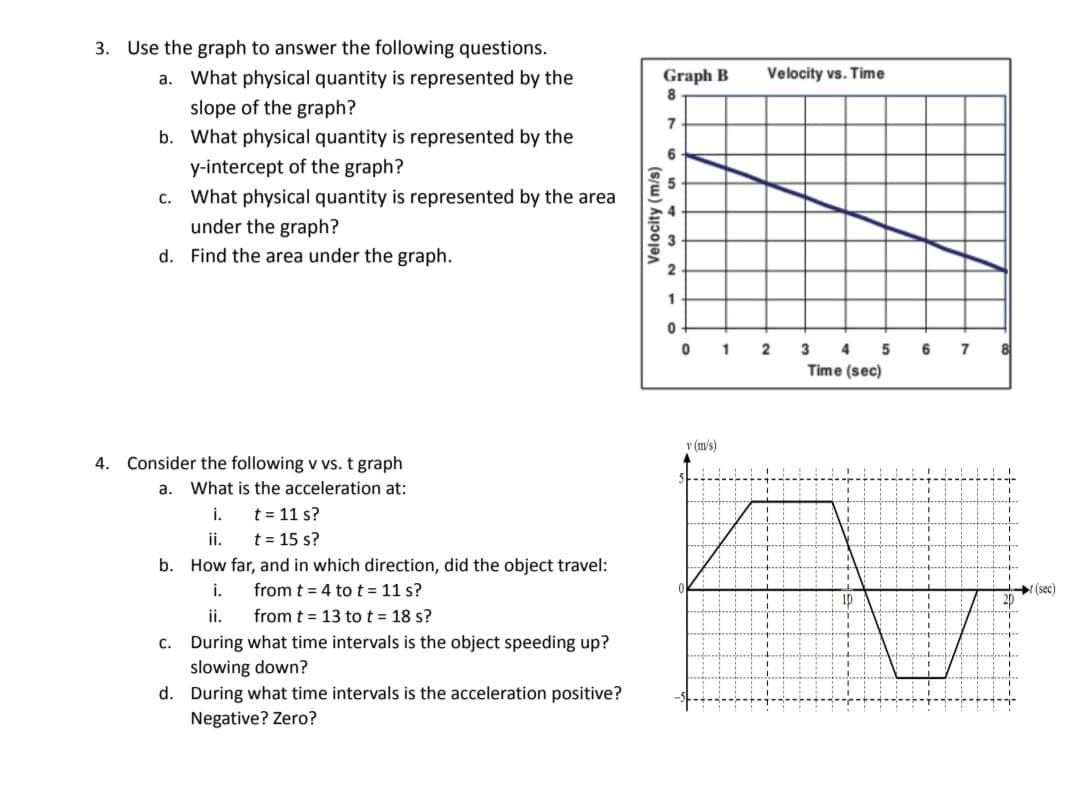3. Use the graph to answer the following questions. a. What physical quantity is represented by the Graph B Velocity vs. Time slope of the graph? 7 b. What physical quantity is represented by the 6 y-intercept of the graph? 5 c. What physical quantity is represented by the area under the graph? d. Find the area under the graph. 2 1 1 2 7 Time (sec) Velocity (m/s)
3. Use the graph to answer the following questions. a. What physical quantity is represented by the Graph B Velocity vs. Time slope of the graph? 7 b. What physical quantity is represented by the 6 y-intercept of the graph? 5 c. What physical quantity is represented by the area under the graph? d. Find the area under the graph. 2 1 1 2 7 Time (sec) Velocity (m/s)
College Physics
11th Edition
ISBN:9781305952300
Author:Raymond A. Serway, Chris Vuille
Publisher:Raymond A. Serway, Chris Vuille
Chapter1: Units, Trigonometry. And Vectors
Section: Chapter Questions
Problem 3P: A shape that covers an area A and has a uniform height h has a volume V = Ah. (a) Show that V = Ah...
Related questions
Question

Transcribed Image Text:3. Use the graph to answer the following questions.
a. What physical quantity is represented by the
Graph B
Velocity vs. Time
slope of the graph?
7
b. What physical quantity is represented by the
6
y-intercept of the graph?
c. What physical quantity is represented by the area
5
under the graph?
d. Find the area under the graph.
1
1
3
4
6
7
Time (sec)
v (m/s)
4.
onsid
the following v vs. t graph
a. What is the acceleration at:
i.
t = 11 s?
ii.
t = 15 s?
b. How far, and in which direction, did the object travel:
i.
from t = 4 to t = 11 s?
(sec)
ip
ii.
from t = 13 tot = 18 s?
c. During what time intervals is the object speeding up?
slowing down?
d. During what time intervals is the acceleration positive?
Negative? Zero?
Velocity (m/s)
Expert Solution
This question has been solved!
Explore an expertly crafted, step-by-step solution for a thorough understanding of key concepts.
This is a popular solution!
Trending now
This is a popular solution!
Step by step
Solved in 2 steps

Recommended textbooks for you

College Physics
Physics
ISBN:
9781305952300
Author:
Raymond A. Serway, Chris Vuille
Publisher:
Cengage Learning

Physics for Scientists and Engineers: Foundations…
Physics
ISBN:
9781133939146
Author:
Katz, Debora M.
Publisher:
Cengage Learning

College Physics
Physics
ISBN:
9781285737027
Author:
Raymond A. Serway, Chris Vuille
Publisher:
Cengage Learning

College Physics
Physics
ISBN:
9781305952300
Author:
Raymond A. Serway, Chris Vuille
Publisher:
Cengage Learning

Physics for Scientists and Engineers: Foundations…
Physics
ISBN:
9781133939146
Author:
Katz, Debora M.
Publisher:
Cengage Learning

College Physics
Physics
ISBN:
9781285737027
Author:
Raymond A. Serway, Chris Vuille
Publisher:
Cengage Learning

Physics for Scientists and Engineers, Technology …
Physics
ISBN:
9781305116399
Author:
Raymond A. Serway, John W. Jewett
Publisher:
Cengage Learning

College Physics
Physics
ISBN:
9781938168000
Author:
Paul Peter Urone, Roger Hinrichs
Publisher:
OpenStax College

University Physics Volume 1
Physics
ISBN:
9781938168277
Author:
William Moebs, Samuel J. Ling, Jeff Sanny
Publisher:
OpenStax - Rice University